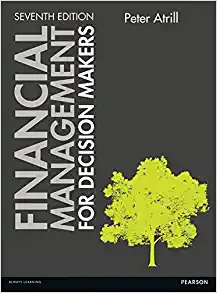Question
Chapter 9 Study Guide Part I: Single project Consider the following scenario. You are reviewing a new project and have estimated the following cash flows:
Chapter 9 Study Guide
Part I: Single project
Consider the following scenario.
You are reviewing a new project and have estimated the following cash flows:
Year 0: CF = -165,000
Year 1: CF = 63,120; NI = 13,620
Year 2: CF = 70,800; NI = 3,300
Year 3: CF = 91,080; NI = 29,100
Your required return for assets of this risk level is 12%.
1) Using payback period method to make capital budgeting decision.
2) Using discounted payback period method to make capital budgeting decision.
3) Using net present value method (NPV)
4) Using profitable index method (PI)
5) Using the Internal Rate of Return method (IRR)
6) Using modified IRR method (MIRR) on slide 75
Part II: Multi-Projects
| Period | Project A | Project B |
| 0 | -500 | -400 |
| 1 | 325 | 325 |
| 2 | 325 | 200 |
| IRR | ||
| NPV |
If the required rate of return is 10%. Which project shall you choose?
1) How much is the cross over rate?
2) How is your decision if the required rate of return is 13%?
3) Rule for mutually exclusive projects:
4) What about the two projects are independent?
More on IRR (non-conventional cash flow) (slide 73)
Suppose an investment will cost $90,000 initially and will generate the following cash flows:
Year 1: 132,000
Year 2: 100,000
Year 3: -150,000
The required return is 15%. Should we accept or reject the project?
1) How does the NPR profile look like?
2) IRR1=
3) IRR2=
Exercise (slide 82)
An investment project has the following cash flows:
CF0 = -1,000,000; C01 C08 = 200,000 each
If the required rate of return is 12%, what decision should be made using NPV?
How would the IRR decision rule be used for this project, and what decision would be reached?
How are the above two decisions related?
Question 1: Project with an initial cash outlay of $20,000 with following free cash flows for 5 years.
Year Cash flows
1 $8,000
2 4,000
3 3,000
4 5,000
5 10,000
1) How much is the payback period (approach one)?
2) If the firm has a 10% required rate of return. How much is NPV (approach 2)?
3) If the firm has a 10% required rate of return. How much is IRR (approach 3)?
4) If the firm has a 10% required rate of return. How much is PI (approach 4)?
Question 2: Project with an initial cash outlay of $60,000 with following free cash flows for 5 years.
Year FCF
Initial outlay 60,000
1 25,000
2 24,000
3 13,000
4 12,000
5 11,000
The firm has a 15% required rate of return.
Calculate payback period, NPV, IRR and PI. Analyze your results.
Question 3: Mutually Exclusive Projects
1) Consider the following cash flows for one-year Project A and B, with required rates of return of 10%. You have limited capital and can invest in one but one project. Which one?
Initial Outlay: A = $200; B = $1,500
Inflow: A = $300; B = $1,900
2) Example: Consider two projects, A and B, with initial outlay of $1,000, cost of capital of 10%, and following cash flows in years 1, 2, and 3:
A: $100 $200 $2,000
B: $650 $650 $650
Which project should you choose if they are mutually exclusive? Independent? Crossover rate
Step by Step Solution
There are 3 Steps involved in it
Step: 1

Get Instant Access to Expert-Tailored Solutions
See step-by-step solutions with expert insights and AI powered tools for academic success
Step: 2

Step: 3

Ace Your Homework with AI
Get the answers you need in no time with our AI-driven, step-by-step assistance
Get Started


